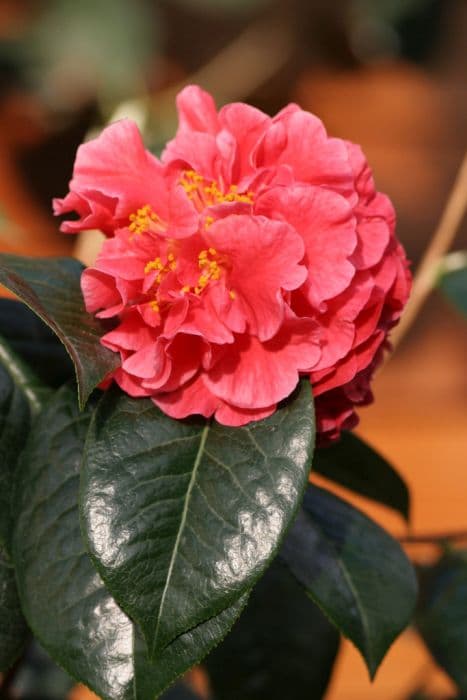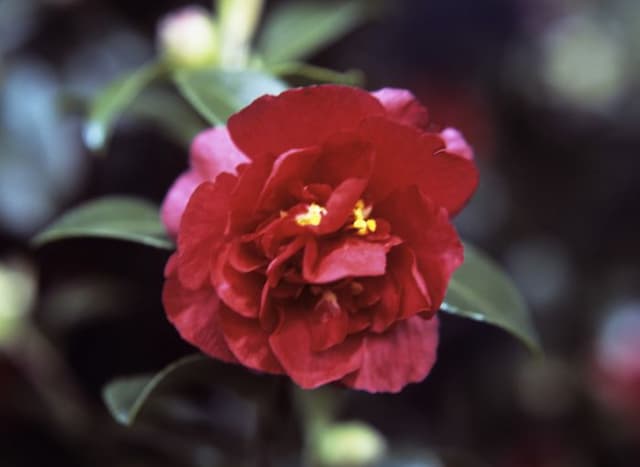Japanese camellia Camellia japonica 'Coquettii'

ABOUT
The plant known commonly as the Japanese camellia, specifically the 'Coquettii' variety, boasts lustrous, evergreen foliage that presents a rich, dark green color. The leaves are glossy and leathery with a smooth margin, and they are oval to broadly elliptical in shape, providing a striking backdrop to the flowers. The 'Coquettii' is particularly admired for its showy blooms, which typically appear in the cooler months when fewer plants are in flower. These blossoms are large and eye-catching, showcasing a blend of delicate pink and deep rose shades, often with bright, prominent yellow stamens at the center. The petals are arranged in a peony-like form, which means they are numerous and overlapping, adding to the plant's dramatic appearance. These double flowers have a romantic and ruffled look, giving the plant an ornamental quality that is highly prized in gardens. Together, the dark green foliage and vibrant pink flowers make the 'Coquettii' a standout in any landscape where it is grown, adding a burst of color and elegance to the setting. Its flowers not only add aesthetic value but are also known for their longevity, often gracing the plant for an extended bloom period.
About this plant
 Names
NamesFamily
Theaceae
Synonyms
Japanese Camellia, Camellia, Common Camellia
Common names
Camellia japonica 'Coquettii'.
 Toxicity
ToxicityTo humans
Camellia is not considered toxic to humans. Therefore, ingesting parts of the Japanese Camellia, commonly known as Camellia, typically does not result in poisoning, and there should be no symptoms associated with toxicity. However, it is always advisable to exercise caution and avoid eating ornamental plants as a general safety practice.
To pets
Camellia is not considered toxic to pets. Ingesting parts of this plant, commonly known as Camellia, should not result in any toxic symptoms for animals such as dogs and cats. While there should be no consequences of ingestion, pet owners should always monitor their pets for any unusual behavior or reactions after ingesting plant material, as individual sensitivities can vary.
 Characteristics
CharacteristicsLife cycle
Perennials
Foliage type
Evergreen
Color of leaves
Green
Flower color
Pink
Height
6-10 feet (1.8-3.0 meters)
Spread
5-7 feet (1.5-2.1 meters)
Plant type
Shrub
Hardiness zones
7
Native area
Japan
Benefits
 General Benefits
General Benefits- Ornamental Value: Camellia japonica 'Coquettii', commonly known as Japanese Camellia, has large, showy flowers that add aesthetic appeal to gardens and landscapes.
- Long Blooming Season: It typically blooms from winter to early spring, providing color during a time when few other plants are in flower.
- Shade Tolerance: The plant can thrive in partial shade, which makes it suitable for woodland gardens and areas with dappled sunlight.
- Ease of Cultivation: Japanese Camellia is generally easy to grow with the right conditions and is relatively low maintenance.
- Versatility: It can be trained into various forms such as shrubs or small trees, and it is also suitable for containers.
- Evergreen Foliage: The glossy, dark green leaves remain throughout the year, offering continuous visual interest even when the plant is not in bloom.
- Soil Adaptability: It can adapt to a range of soil types, though it prefers well-draining, acidic soil.
- Wildlife Attraction: The flowers provide nectar for pollinators such as bees during the blooming season.
- Screening and Privacy: Due to its dense foliage, it can be used as a privacy screen or hedge.
 Medical Properties
Medical PropertiesThis plant is not used for medical purposes.
 Air-purifying Qualities
Air-purifying QualitiesThis plant is not specifically known for air purifying qualities.
 Other Uses
Other Uses- As an art medium, Camellia japonica 'Coquettii' flower petals can be pressed and used in botanical art projects for their vibrant color and sturdy texture.
- In the culinary world, petals of Camellia japonica 'Coquettii' are sometimes crystallized and used as elegant edible decorations atop cakes and pastries.
- As a natural dye, the petals of the Camellia japonica 'Coquettii' can be boiled to extract a light pink or greenish-yellow color for use in fabric or craft dyeing.
- For educational purposes, the Camellia japonica 'Coquettii' can be part of a plant identification kit in horticultural studies, helping students learn to identify various species.
- In photography, the striking blooms of the Camellia japonica 'Coquettii' often serve as a popular subject for nature and macro photography.
- As a source of inspiration, the vivid blossoms of the Camellia japonica 'Coquettii' are frequently used as muse in floral design and botanical illustration courses.
- During cultural festivals, especially in East Asia, branches of Camellia japonica 'Coquettii' can be used in traditional decorations to symbolize desire and passion.
- In the craft of perfumery, while not a common ingredient, the delicate scent of Camellia japonica 'Coquettii' can be captured to create unique floral fragrances.
- For ornamental carvings, the hardwood of the Camellia japonica 'Coquettii' lends itself well to detailed work and can be incorporated into intricate woodworks.
- As a symbol in literature and poetry, Camellia japonica 'Coquettii' has been used to convey messages of adoration or as a metaphor for transient beauty due to its short bloom time.
Interesting Facts
 Feng Shui
Feng ShuiCamellia is not used in Feng Shui practice.
 Zodiac Sign Compitability
Zodiac Sign CompitabilityCamellia is not used in astrology practice.
 Plant Symbolism
Plant Symbolism- Love: The camellia flower is often associated with love, particularly deep, passionate love. It is given between lovers to express desire and deep affection.
- Admiration: The intricate beauty and perfection of the camellia's petals represent admiration and the awe one might feel for another person's qualities.
- Perfection: Due to its perfectly formed blooms, the camellia symbolizes the ideal of perfection and is often used to convey the flawless beauty of someone.
- Longevity and Faithfulness: Camellias are evergreen plants and have a long blooming season, which symbolically conveys the enduring nature of love and the faithfulness between partners.
- Refinement: The smooth textures and delicate form of camellia blooms are suggestive of refinement and speak to a person's cultured and polished characteristics.
 Water
WaterThe Japanese Camellia 'Coquettii' should be watered thoroughly, allowing the water to penetrate deeply into the soil, promoting healthy root growth. This plant prefers consistent moisture and should be watered when the top inch of soil begins to feel dry. Typically, this could mean watering the plant once or twice a week, depending on climate conditions and the plant's environment. During active growth in spring and summer, you may need about 1-2 gallons of water per week, but reduce watering in the fall and winter when the plant is not growing vigorously. It's important to avoid overwatering to prevent root rot.
 Light
LightThe Japanese Camellia 'Coquettii' thrives in partial shade to filtered sunlight, making it suited for an eastern or northern exposure where it receives some morning light but is protected from intense afternoon sun. An ideal spot would be under the canopy of larger trees that provide dappled sunlight, as too much direct sunlight can cause leaf scorch.
 Temperature
TemperatureThe Japanese Camellia 'Coquettii' prefers a temperate climate with temperatures ranging between 40 to 85 degrees Fahrenheit. The plant should be protected from extreme temperatures, particularly avoiding exposure to temperatures below 20 degrees Fahrenheit, which could cause damage, and similarly, temperatures above 90 degrees Fahrenheit can stress the plant. The ideal temperature range for camellias is between 50 to 70 degrees Fahrenheit.
 Pruning
PruningPrune Japanese Camellia 'Coquettii' primarily to maintain shape and remove any dead or diseased wood. It's best to prune just after blooming has finished in late winter or early spring, as this helps not to disrupt the following year's buds. Light pruning each year helps encourage bushier growth and better airflow within the plant.
 Cleaning
CleaningAs needed
 Soil
SoilJapanese Camellia 'Coquettii' thrives best in acidic soil with a pH between 5.5 and 6.5. The ideal soil mix should be well-draining and rich in organic matter, comprising equal parts of peat moss, leaf mold, and coarse sand or perlite. Regularly check soil pH and amend with sulfur or peat moss to maintain acidity.
 Repotting
RepottingJapanese Camellia 'Coquettii' should be repotted approximately every 2 to 3 years. The best time to repot is late winter or early spring before new growth starts. Choose a slightly larger pot to allow for growth and refresh with acidic compost.
 Humidity & Misting
Humidity & MistingJapanese Camellia 'Coquettii' favors high humidity levels, ideally between 50% to 60%. To maintain optimum humidity, use a humidifier or place the pot on a humidity tray filled with pebbles and water, ensuring that the pot doesn't sit directly in the water.
 Suitable locations
Suitable locationsIndoor
Place in bright, indirect light and keep soil slightly moist.
Outdoor
Plant in partial shade, sheltered from strong winds.
Hardiness zone
7-9 USDA
 Life cycle
Life cycleThe Camellia japonica 'Coquettii', commonly known as the Japanese Camellia, begins its life as a seed, which requires stratification to break dormancy and germinate. Upon germination, the seedling develops a taproot and begins to grow its first true leaves; within a few months, a young plant structure is established. The camellia enters a vegetative growth phase in which it develops a woody stem and evergreen glossy green leaves, gradually forming a bushy shrub. It reaches flowering maturity after a few years, producing its large, attractively colored and often variegated flowers primarily in late winter to early spring. After pollination, the flowers develop into dry capsules which eventually open to release seeds, continuing the reproductive cycle. Throughout its life cycle, the Japanese Camellia can be pruned and shaped, often being cultivated as an ornamental plant in gardens, and can live for many decades if provided with proper care.
 Propogation
PropogationPropogation time
Spring-Early Summer
Propogation: The best time to propagate Camellia japonica 'Coquettii', commonly known as Japanese camellia, is typically in late summer to early fall, when the plant is still semi-active. The most popular method of propagation for Japanese camellia is by semi-hardwood cuttings. To carry out this process you take cuttings of about 4 to 6 inches long from new growth that has started to firm up. The leaves on the lower half of the cutting should be removed, and the cut end can be treated with rooting hormone to encourage root development. The treated cutting is then placed in a well-draining potting mix, with about half of the cutting length buried into the soil. The cuttings should be kept in a warm, humid environment, ideally with a temperature between 70 to 75 degrees Fahrenheit (21 to 24 degrees Celsius), and should be kept moist but not waterlogged. Roots typically develop within several weeks, after which the cuttings can gradually be acclimatized to less humid conditions before being planted out.









